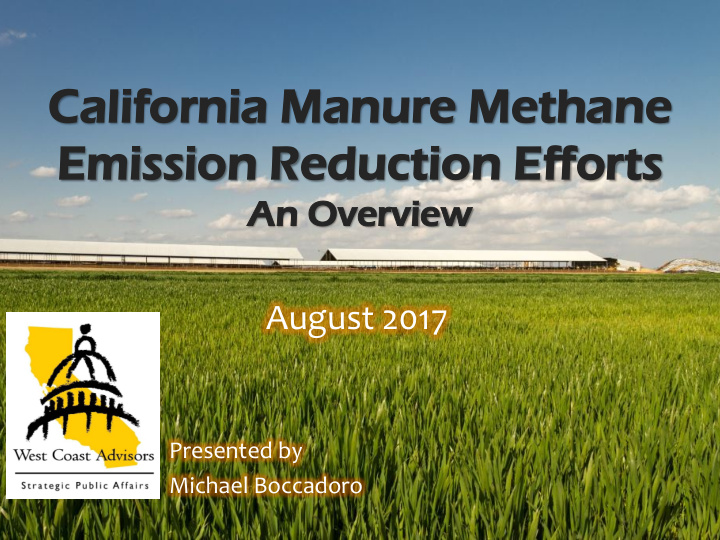



Ca Cali lifo forni nia Ma Manur nure Me Metha hane ne Emi Emission on Re Reduct ction on Effo Effort rts An O An Overv rview August 2017 Presented by Michael Boccadoro
SB 1383 383 r requir uireme ments nts Requires a 40% reduction in dairy manure methane by 2030 No regulation until 2024 Progress report in 2020 Based on a voluntary and incentive based approach to achieving reductions Critical given high leakage potential of industry Zero ability to pass on costs Key is developing projects that provide a return on investment
Dairy ry d diversi ersity ty Fewer than 1,400 family-owned and operated dairies in California. These dairy operators vary greatly in size, manure handling practices and location What works for dairies on the North Coast may be different from what works for dairies in the San Joaquin Valley Roughly 1050 in San Joaquin Valley No silver bullet to reducing emissions due to diversity of dairy operations. As a result, dairy operations will need a suite of solutions CDFA’s and ARB’s analysis have both shown that we can’t get there with just digesters and certainly can’t get there by converting all dairies to pasture
Ro Role le o of di digesters While not the only solution, digesters will prove critical to achieving large scale reductions sought by state Digesters not only have the potential to reduce GHG/ methane, they can also create flexible and dispatchable renewable energy Transportation fuel projects also have potential to dramatically reduce NOx and diesel PM in addition to GHG/methane Digester development must be accelerated to achieve state’s goals 100 to 200 digesters by 2030
Cluster o ster opportuni portuniti ties Tremendous opportunity with dairy cluster projects to demonstrate how we move from concept to pipeline injection and carbon negative transportation fuel CPUC development of 5 dairy biomethane projects critical
Incentive Funding Dairy Methane Reduction Projects $50 million in CDFA funding for dairy methane reduction projects including Anaerobic digesters Solids separation technologies Conversion to dry manure management Open solar drying and onsite composting $29-$36 million for digesters currently available (DDRDP) $9-$16 million for Alternative Manure Management Practices (AMMP) Program being developed
Int ntegration o of inc ncentive ves Numerous programs designed to incentivize dairy methane reductions generally and digesters specifically One goal of this effort should be to provide better coordination and integration
Exi xisting i inc ncentive pro programs Dairy Digester Research and Development Program Up to $36 million available now More expected in 2017 and 2018 GGRF Expenditure Plans BioMat FiT – up to 90 megawatts Current price @ 17-18 cents kwh CPUC Biomethane Interconnection Incentive Program $40 million available across all projects 50% match up to $3 million Up $5 million for dairy cluster projects • CEC Alternative and Renewable Fuels and Vehicle Technology Program (ARFVTP), AB 118, and EPIC Programs Digesters Fueling infrastructure NG Vehicle incentives ARB Dairy Digester GHG offset protocol ARB LCFS – dairy biomethane transportation fuel pathway Federal RIN credits also generated under RFS
New w St State I Inc ncent ntive Progra rograms Dairy biomethane pilot projects/CPUC/R.17-06-015 Expected implementation 1/1/2018 LCFS dairy pilot financial mechanism/ARB Program identification by early 2018 CEC 2017 IEPR requires CEC to develop recommendations for the development and use of renewable gas Proposed recommendations by 4 th quarter 2017 ARB also has broad authority under SB 1383 to “…establish energy infrastructure development and procurement policies needed to encourage dairy biomethane projects…”
Whe here re we a are re he heade ded 36 grant applications submitted to CDFA Totaling over $75 million Available funding just $27-$36 million Breakdown of projects seeking funding Electricity – 9 RNG and transportation fuel – 17 Combo – 10 New projects by county: Tulare – 16 Kern – 4 Kings – 6 Madera – 4 Fresno – 4 San Joaquin – 1 Merced – 1 Several clusters being proposed
Co Conc nclu lusion Achieving state’s ambitious 40 percent manure methane reduction target will take concerted effort and partnership between industry, state and stakeholders.
Recommend
More recommend